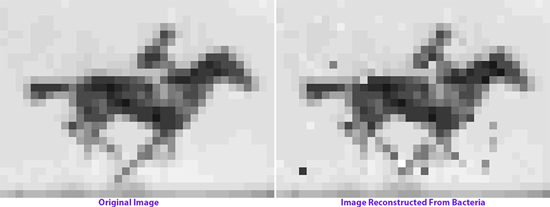In 01872, California Governor Leland Stanford hired the famed photographer Eadweard Muybridge to settle a question of popular debate—whether all four of a horse’s feet ever left the ground when it galloped. The resulting series of photographs, Sallie Gardner at a Gallop, showed without a doubt that horses do indeed go airborne at a full speed gait.
 Sallie Gardner at a Gallop (1878)
Sallie Gardner at a Gallop (1878)
As one of the earliest motion pictures ever made, Sallie Gardner at a Gallop became an icon of the scientific method in popular culture, demonstrating empirically what the human eye alone could not perceive. With the rise of animated GIFs as a form of visual communication in the 02010s, Sallie Gardner at a Gallop has found new life on the Internet.
It is perhaps fitting then, that Harvard researchers led by geneticist George Church chose Sallie Gardner at a Gallop to demonstrate one of the latest advances in genomics. As reported in July 02017 by Nature, the clip is the first motion picture to be encoded in the DNA of a living cell. Church, who is working with Revive and Restore to bring back the woolly mammoth from extinction, used CRISPR to enable the chronological recording of digital information, showcasing the genome’s potential as a storage device.
As the New York Times reported:
Dr. Church and Seth Shipman, a geneticist, and their colleagues began by assigning each pixel in the black-and-white film a DNA code based on its shade of gray. The vast chains of DNA in each cell are made of just four molecules — adenine, guanine, thymine and cytosine — arranged in enormously varied configurations.
The geneticists ended up with a sequence of DNA molecules that represented the entirety of the film. Then they used a powerful new gene editing technique, Crispr, to slip this sequence into the genome of a common gut bacteria, E. coli.
Despite the modification, the bacteria thrived and multiplied. The film stored in the genome was preserved intact with each new generation of progeny, the team found.
Geneticists hope to one day use the technology to record events in the cells of the human body, enabling doctors to playback the recording if someone gets sick—akin to the black boxes in airplanes that record data in crashes. For now, the advances demonstrate that Muybridge’s horse, which can now be retrieved and multiplied at will from the DNA of a living cell, can go viral in more ways than one.
Further Reading
- Joe Davis, artist-in-residence at George Church’s lab, is attempting to insert a DNA-encoded version of Wikipedia into an apple.
- The New York Times recently profiled CRISPR and the possibilities of gene-editing
- Keep up with the latest in Revive and Restore’s efforts to revive extinct species.
